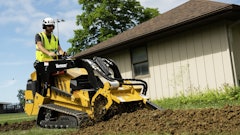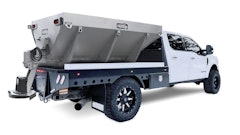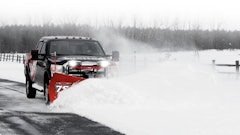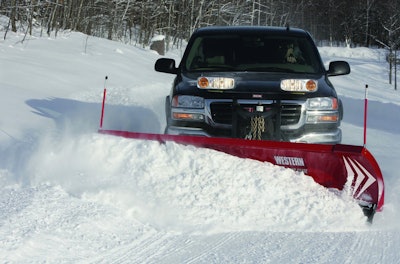
Plowing snow is hard work. Unforgiving work conditions, long hours and demanding clients create a situation where stress levels can climb even faster than the buildup of snow and ice.
When Mother Nature calls and it’s time to spring into action, it’s easy to forget about things like safety and preparedness. THE BOSS Snowplow offers a quick checklist to help ensure that you don’t.
1. Before operating or servicing your snowplow, you should become thoroughly familiar with the owner’s manual.
2. You should carry the following safety equipment for emergencies: fire extinguisher, tool kit, tow strap, flashlight, flares, first aid kit, fuses for your vehicle, jumper cables, ice scraper, lock deicer, extra washer fluid, shovel and a bag of sand or salt. Also, make sure you have warm clothes that include insulated boots, insulated underwear, a warm jacket, hat, gloves and sunglasses.
NOTE: In case of an emergency, it is always a good idea to carry a cellular phone or two-way radio with you when plowing.
3. You should also carry a snowplow emergency parts kit that includes extra hydraulic fluid, hydraulic hoses, a pump solenoid, extra cutting-edge bolts and a trip spring.
4. You should check your vehicle’s tire pressure, engine belts for cracks and tightness, hoses for leaks and vehicle fluid levels including the engine oil, brake fluid, transmission fluid, battery, radiator coolant and windshield washer fluid. Examine the battery terminals for corrosion and make sure the connections are tight. Make sure the vehicle windshield wipers and defrosters are in good shape and working properly. Check the vehicle headlights, brake lights and turn signals to be sure they are in good working order, and make sure your strobe light is working if you have one. Also, look under the vehicle for obvious signs of leaking fluid.
NOTE: You should never run out of fuel, so make sure your fuel tank is full before going out to plow.
5. If you do not have a strobe light or backup lights, you should consider adding them to your vehicle to increase your own visibility, as well as make yourself more visible to others while plowing.
6. To comply with the federal requirements for front and rear weight distribution—and for good traction while plowing—make sure your vehicle has the proper amount of ballast. Ballast should be placed rearward of the back axle toward the tailgate of the vehicle, and it should be properly secured in place.
7. Check your snowplow to make sure all bolts are tight. Look for cracked welds and hydraulic fluid leaks. Make sure the plow lights and turn signals are aligned properly and are in good working order.
8. Check your snowplow cutting edge. An overworn cutting edge can result in costly repairs to the blade later.



![Kubota Snow ah3 Sgv25ua[1]](https://img.greenindustrypros.com/mindful/acbm/workspaces/default/uploads/2025/10/kubota-snowah3sgv25ua1.bAUoUSziui.png?auto=format%2Ccompress&bg=fff&fill-color=fff&fit=fill&h=100&q=70&w=100)

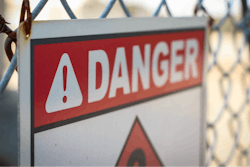


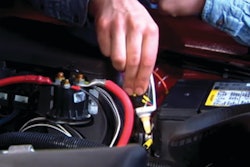
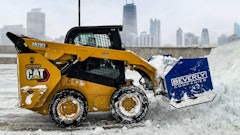

![Kubota Snow ah3 Sgv25ua[1]](https://img.greenindustrypros.com/mindful/acbm/workspaces/default/uploads/2025/10/kubota-snowah3sgv25ua1.bAUoUSziui.png?ar=16%3A9&auto=format%2Ccompress&bg=fff&fill-color=fff&fit=fill&h=135&q=70&w=240)



